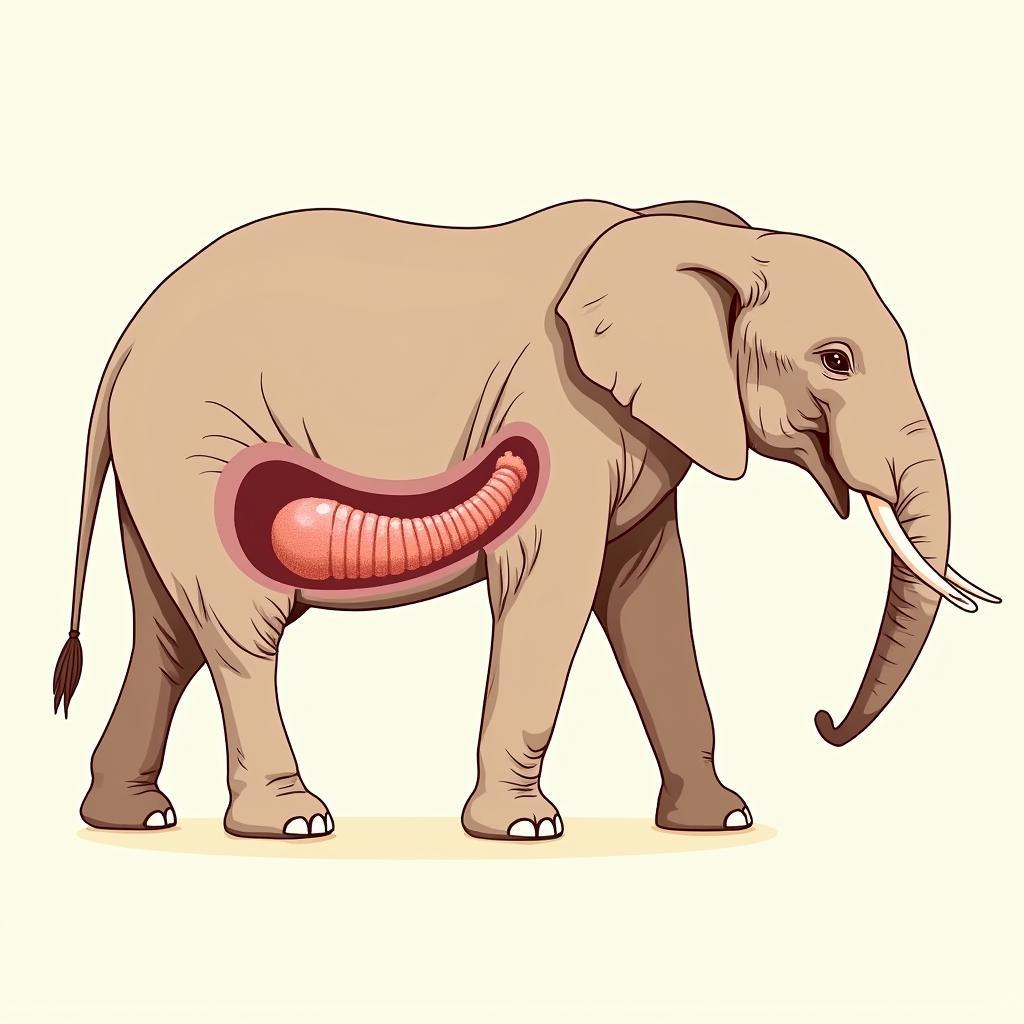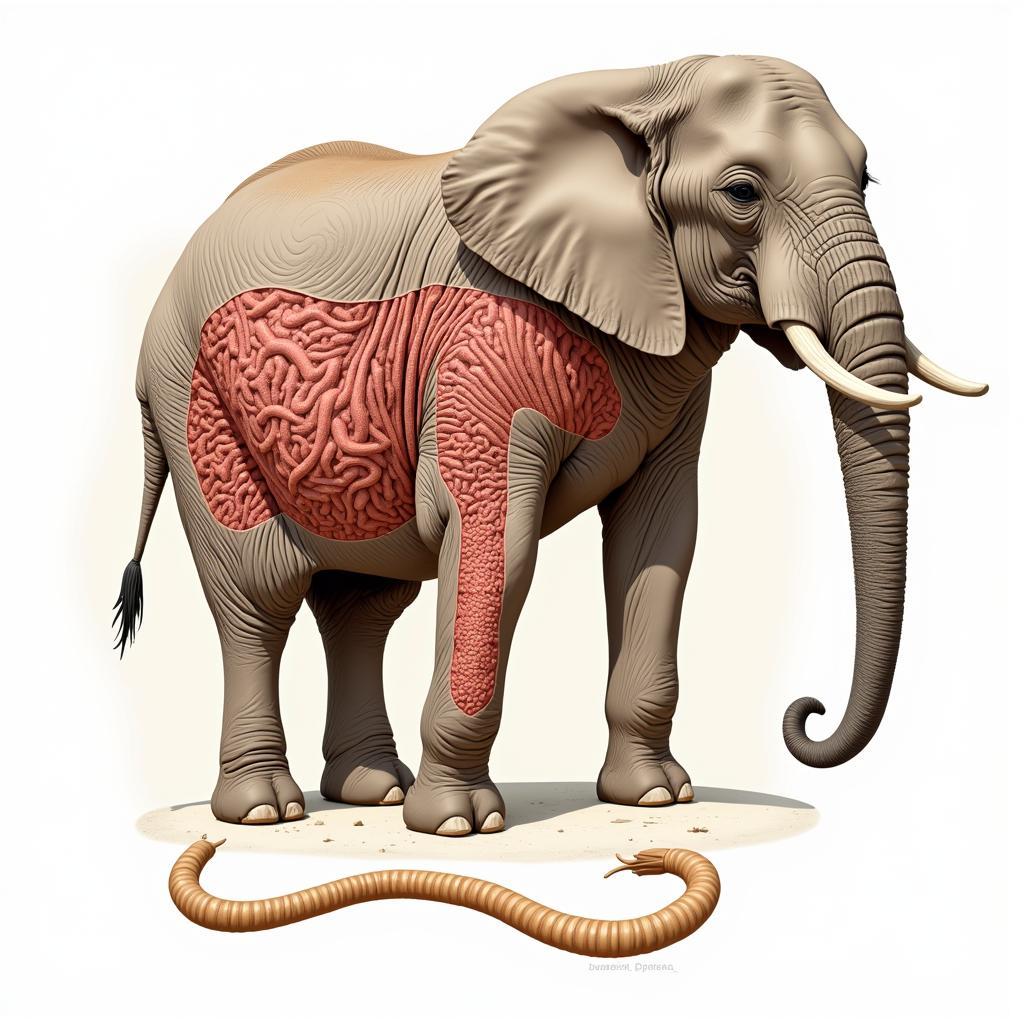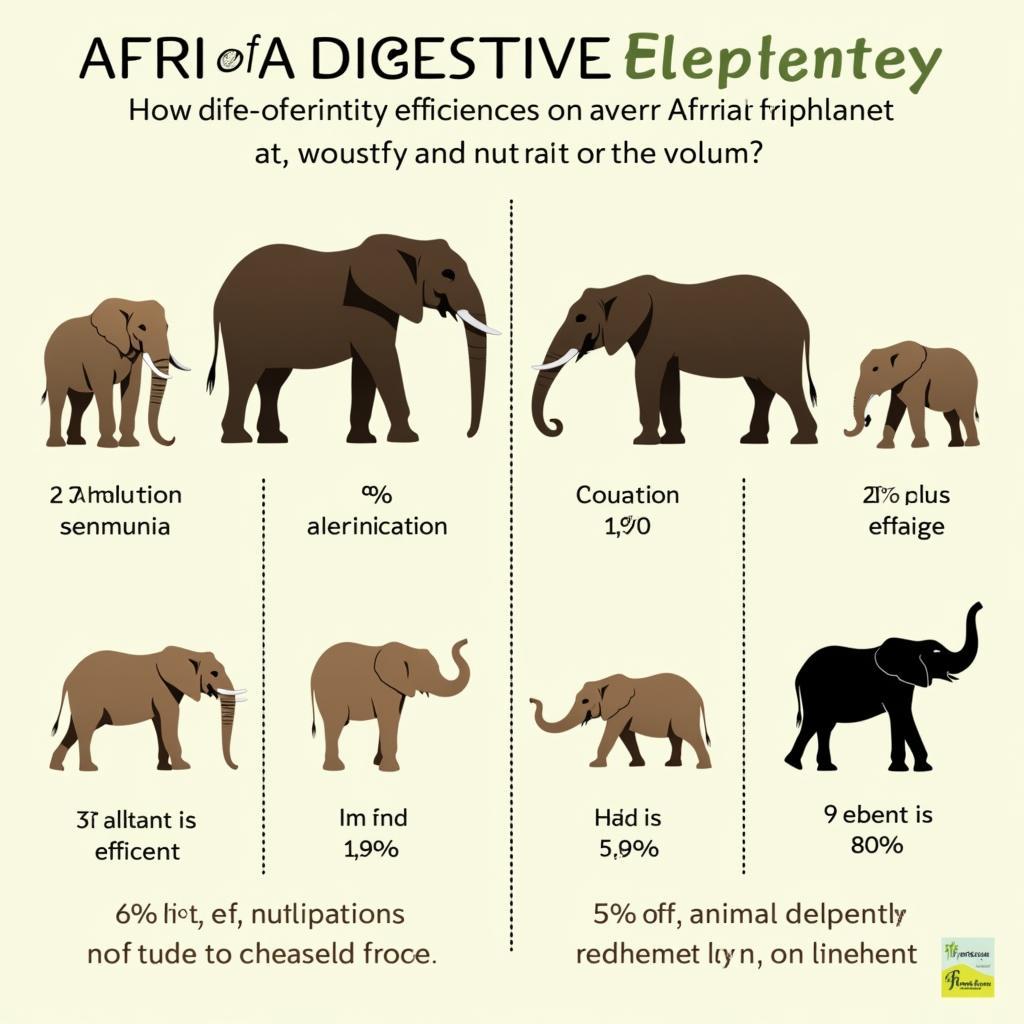Decoding the African Elephant Digestive System
The African Elephant Digestive System is a marvel of evolutionary engineering, perfectly adapted to process vast quantities of plant matter. This intricate system allows these magnificent creatures to extract the nutrients they need from a diet that can include grasses, leaves, bark, and even fruit. Let’s delve into the fascinating world of the African elephant’s digestive process.
African Bush Elephant adaptations demonstrate a clear link between their diet and digestive efficiency. One of the most distinctive features of their digestive system is its hindgut fermentation process. Unlike ruminants like cows, which have multi-compartment stomachs, elephants rely on a large cecum and colon to break down cellulose. This process, aided by a complex community of microorganisms, allows them to extract energy from plant fibers that would otherwise be indigestible. african bush elephant adaptations
The Journey of Food: A Step-by-Step Guide
The digestive journey begins in the elephant’s mouth. Their powerful tusks help them strip bark from trees and dig up roots, while their trunk expertly gathers vegetation and delivers it to their mouth. The molars, massive and ridged, grind the tough plant material into smaller pieces, increasing the surface area for digestive enzymes to work on.
From Mouth to Stomach
Once swallowed, the food travels down the esophagus and into the stomach. The elephant’s stomach is relatively small compared to its overall size and serves primarily as a storage chamber and a site for initial digestion. Here, digestive juices begin to break down the food further.
 African Elephant Stomach Diagram
African Elephant Stomach Diagram
The Role of the Small Intestine
The partially digested food then moves into the small intestine. Although relatively short compared to other herbivores, the small intestine still plays a crucial role in absorbing nutrients. This is where the breakdown of proteins, fats, and simple carbohydrates occurs.
The Cecum and Colon: The Fermentation Hub
The true magic of the African elephant digestive system lies in the cecum and colon. These large compartments house a diverse ecosystem of bacteria, protozoa, and fungi. These microorganisms ferment the cellulose in the plant material, breaking it down into simpler compounds that the elephant can absorb. This fermentation process is essential for the elephant’s survival, allowing them to extract a significant portion of their energy from otherwise indigestible fiber. Knowing more about African herbivores, in general, provides helpful context for understanding this unique process. african herbivores
 African Elephant Cecum and Colon
African Elephant Cecum and Colon
What About Water?
Water plays a vital role in the digestive process, aiding in the movement of food through the digestive tract and facilitating the absorption of nutrients. Elephants consume large quantities of water daily, which is essential for maintaining the efficiency of their digestive system.
Efficiency and Adaptations
The African elephant’s digestive system is remarkably efficient, allowing them to extract around 40% of the nutrients from their food. This is relatively low compared to some other herbivores, reflecting the challenges of digesting large amounts of tough plant material. However, their large body size allows them to process a huge volume of food, compensating for the lower efficiency.
Dr. Anita Weber, a wildlife veterinarian specializing in African megafauna, explains: “The elephant’s digestive system is a testament to the power of adaptation. Their ability to extract energy from fibrous plants is key to their survival in diverse African habitats.”
The Importance of Fat Reserves
While their digestive system is adapted for a herbivorous diet, African elephants can also store significant fat reserves, particularly in specific areas of their body. These reserves serve as a crucial energy source during periods of food scarcity. Learning more about the African elephant fat body can offer further insight into their remarkable adaptations. african elephant fat body
 African Elephant Digestive Efficiency Diagram
African Elephant Digestive Efficiency Diagram
Conclusion
The African elephant digestive system is a complex and fascinating example of how animals adapt to their environment. From the powerful molars grinding tough vegetation to the microbial community fermenting cellulose in the cecum and colon, every aspect of their digestive process is finely tuned to extract the maximum possible nutrition from their plant-based diet. Understanding the African elephant digestive system is crucial for appreciating the unique biology of these magnificent creatures and their role in the African ecosystem. Considering the adaptations of other African animal species adds another layer of understanding to the intricate web of life on the continent. african animal species
FAQ
-
How long does it take for food to pass through an elephant’s digestive system? It can take anywhere from 12 to 46 hours.
-
What is the role of microorganisms in an elephant’s digestion? They break down cellulose, making energy available to the elephant.
-
Why do elephants eat so much? Their digestive system is not very efficient, requiring them to consume large quantities of food.
-
How does the African elephant digestive system compare to a cow’s? Elephants use hindgut fermentation while cows are ruminants with multi-compartment stomachs.
-
What is the significance of the cecum in elephant digestion? It houses the microorganisms that break down cellulose.
-
What happens to indigestible material? It is excreted as dung.
-
How does water contribute to elephant digestion? Water facilitates the movement of food and the absorption of nutrients.
Need More Information?
Check out our related article on African buffalo adaptations in the savanna to further explore animal adaptations in the African ecosystem. african buffalo adaptations in the savanna
You might also be interested in learning more about:
- Elephant social structures
- The impact of habitat loss on elephants
- Conservation efforts for African elephants
For any inquiries or assistance, please contact us: Phone: +255768904061, Email: kaka.mag@gmail.com Or visit us at: Mbarali DC Mawindi, Kangaga, Tanzania. Our customer service team is available 24/7.


